Why I Bought My Wife An Engraved Jaeger-LeCoultre Reverso Classique
This is a family affair: a story of my wife Brigitte, her horse Gucci, my father Neil, and an engraved Jaeger-LeCoultre Reverso Classique.
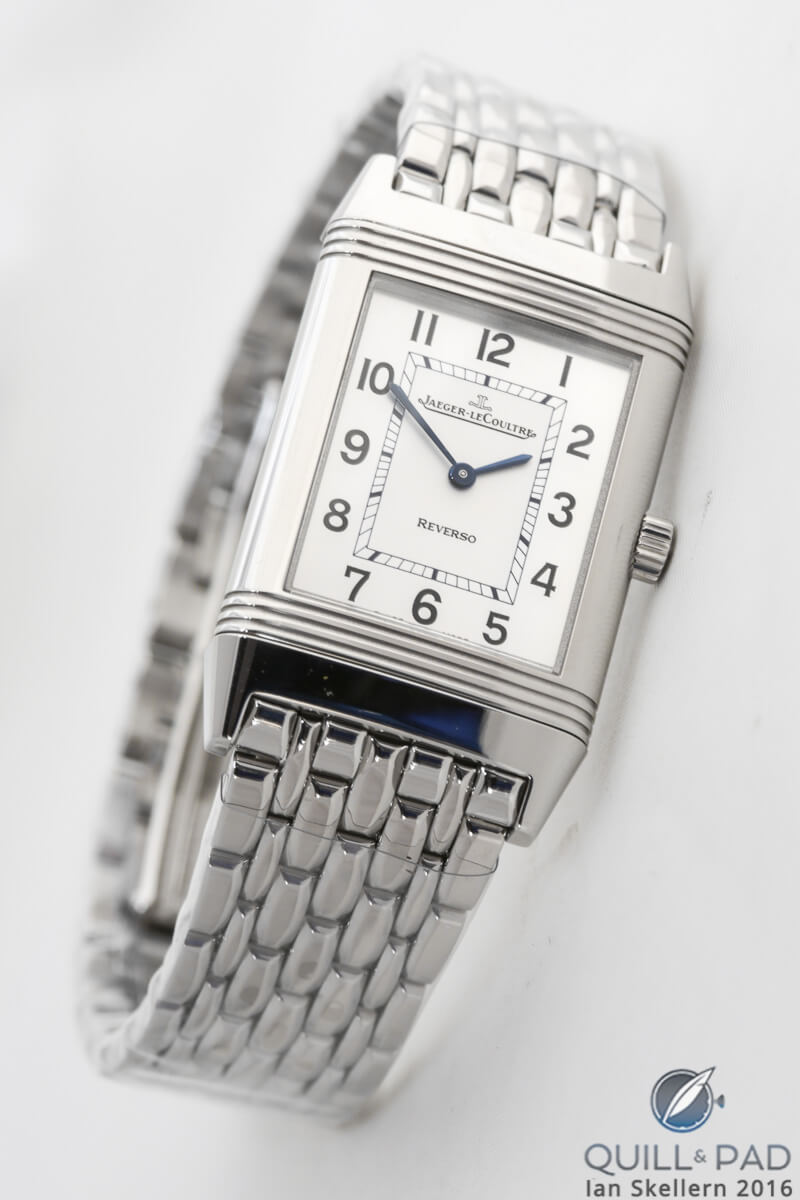
Jaeger-LeCoultre Reverso Classique in stainless steel
Brigitte (wife)
While my wife Brigitte has learnt quite a lot about horology by assimilation over the decades, I think that it is fair to describe her general interest in watches and watchmaking as minimal. But she does know a lot of great watchmakers and she appreciates quality.
Decades ago, after six months of quietly drip-feeding her information about what makes great watchmaking truly great with the goal of preparing the way for buying another watch for myself, she surprised me with, “I get it. I’d like a nice watch.”
It turned out that meant, “I get it. I’d like a Breguet.”
At the time, in her mind Breguet was synonymous with haute horlogerie and she selected a Breguet Marine that she has worn nearly every day since.
It’s worth noting here that we live near Geneva and have horses at home — one is ours, the other two belong to friends. Brigitte rides Gucci, her horse, daily and competes in dressage, which is basically equine gymnastics.
Ian (me)
While online my life may appear to be a world full of wristwatches and watchmakers, in real life horses play a very significant role despite the fact that I rarely ride. I grew up with horses in Australia thanks to my sister Lesley basically sucking the whole family — except me — into her passion.
While I like horses in general, I’ve always thought that they were too much work for too little pleasure. My sister ended up being the chief instructor of our local pony club, my brother Greg rode (and naturally had his own horse), my father became president of the pony club, while my mother was the treasurer.
I liked cars and motorbikes better because I (usually) found them easier to control than horses for both direction and speed.
Neil (father)
When he was in his early fifties, my father was looking for a hobby he could do at home. One day he looked at a framed photo on a wall of my mother Gwen as a debutant and thought, “I think I can paint that.”
And he did. And it turned out okay. But he also learnt that he would be better if he had a few lessons.
So he took a couple of classes on acrylic painting — water-based so there was less smell and it was easier to clean the brushes and himself. However, by this time us kids had grown up and left home (overseas in my case). My parents relocated, and Neil was busy with a new career so painting was forgotten for the next ten years.
But approaching retirement, Neil took art classes run by the University of the Third Age, where he had a tutor specializing in drawing and perspective.
Neil’s sketching process is to work from a photo of the subject that he mentally resizes for the canvas he is working on and draws freehand.
Neil has no interest in sitting in the country painting or drawing; he takes a photo and creates his art in the comfort of his own home. I was completely unaware of my father’s interest in art as I had left Australia before it started.
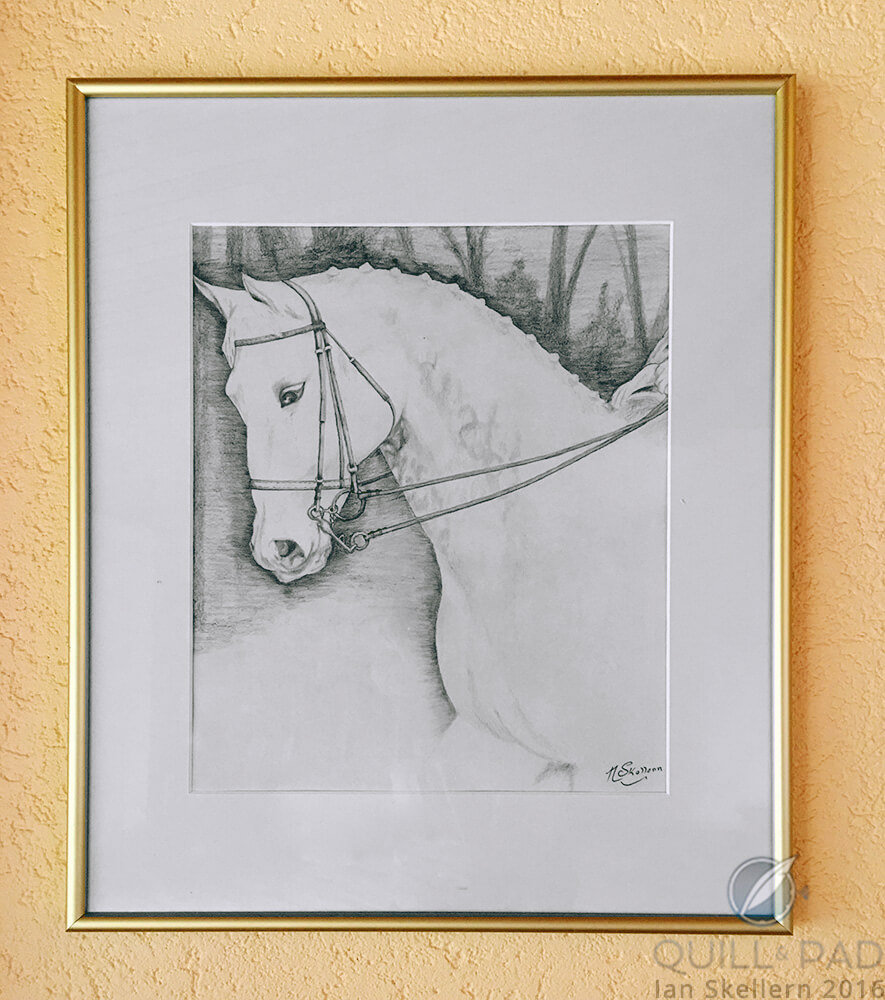
Sketch of Grisou by Neil Skellern
However, over the last decade or so my parents have visited us in Switzerland every few years. On the first visit Neil sketched Brigitte’s previous horse, Grisou. Then he stopped sketching and drawing.
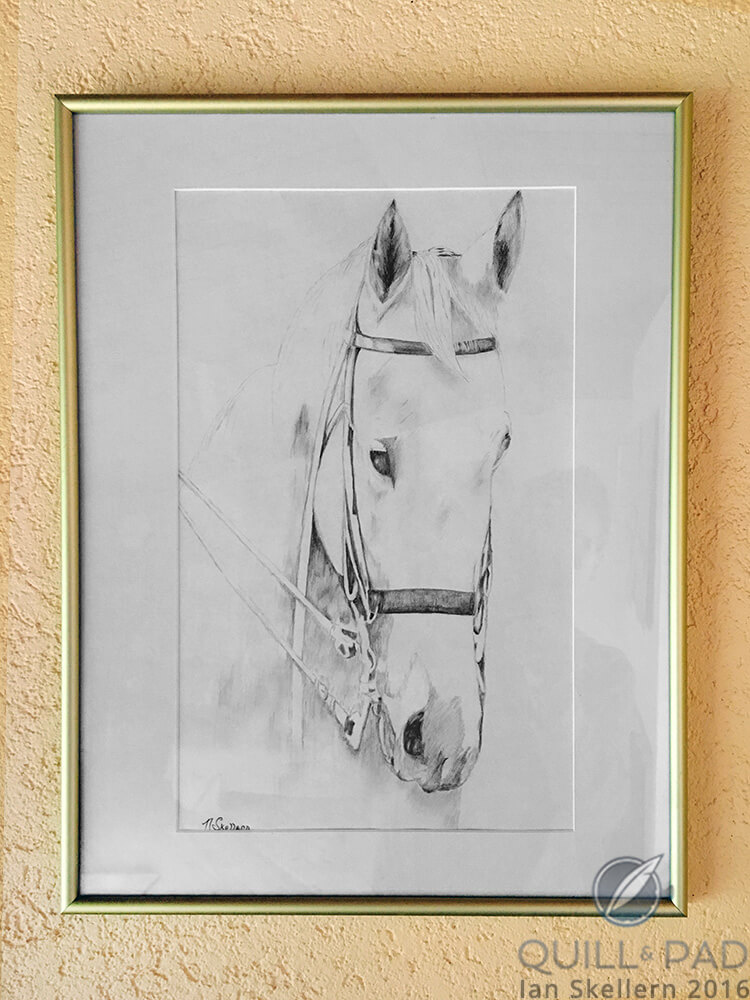
Sketch of Grisou by Neil Skellern
Until five years later when visiting us again in Switzerland I asked him to sketch my much-missed dog Bandit from a favorite photo. And he did. And it was just perfect.
The sketches of Grisou, a grey — nearly white — horse, were really like negatives; there are few lines or shading on the horse itself.
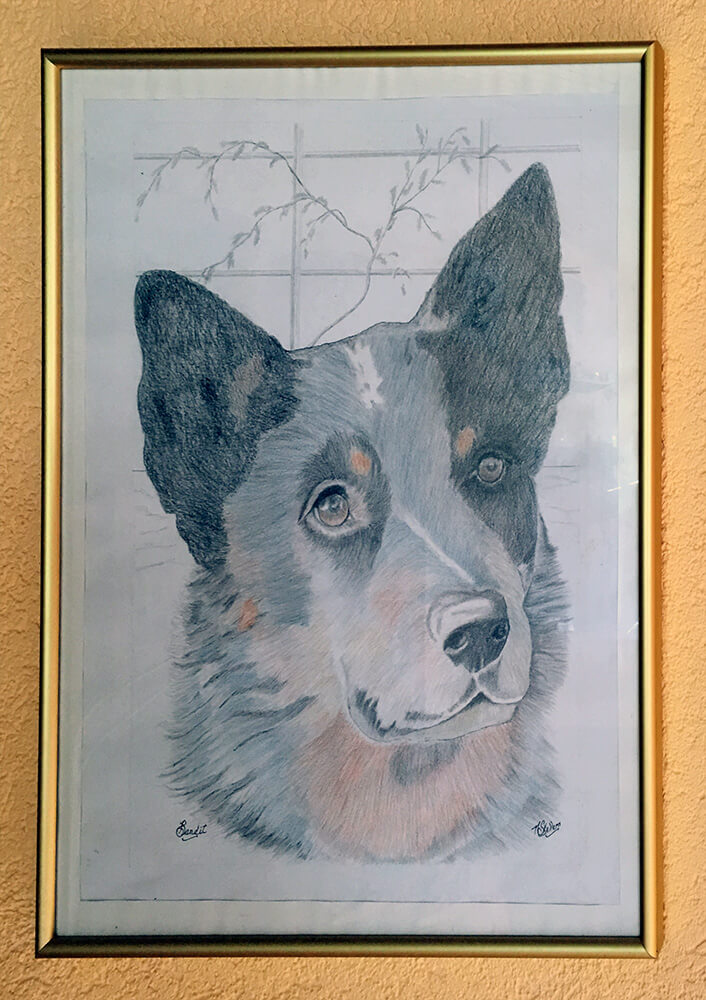
Sketch of Bandit by Neil Skellern
Bandit, though, was the opposite: it was full of lines and shading. And the sketch of Bandit taught me something that I had never even come close to experiencing before: the power of art.
Bandit died around five years ago, yet I still easily tear up every time I think about him or look at his sketch. (And I’m comfortable with that.)
While I’ve been extremely fortunate to have seen great art all over the world, and I do appreciate the talent, effort, ingenuity, and creativity that goes into art, I’ve never had any type of art move me before.
The sketch of Bandit really showed me that Neil had talent, because I loved my dog more than Brigitte’s horse (which was also basically a pet at home) so I studied that sketch more.
Gucci
A few more years passed. My parents visited again, and this time Neil sketched Brigitte’s current horse, Gucci (he came with the name).
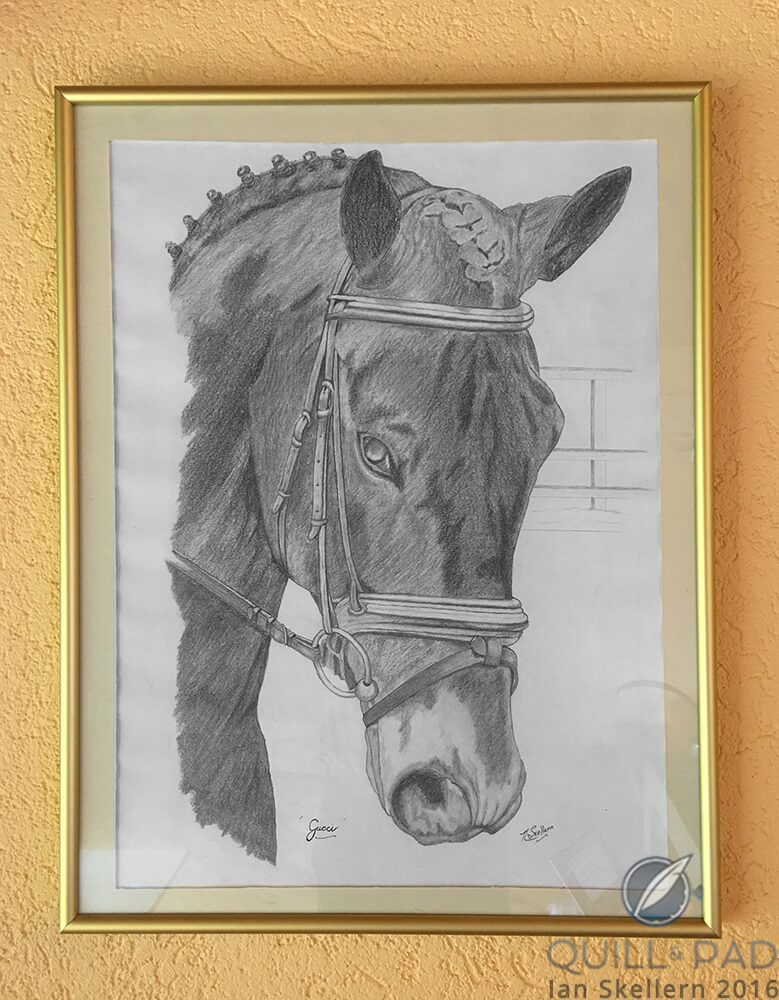
Sketch of Gucci by Neil Skellern
After Grisou died, we learnt that a decent dressage horse for competing at Brigitte’s level was beyond our budget. She was borrowing a friend’s horse to compete, but that wasn’t a long-term solution.
One thing we knew, though, was not to get a foal. Even though we have stables and paddocks on our property, so it would be relatively affordable for us to keep a young horse, in the years that they are growing up, foals can easily hurt themselves badly enough to rule out future hopes of high-level competition. And as with children, two great dressage horses don’t necessarily make a great dressage horse.
Then one day I saw a photo of a six-month-old colt in Sweden that was for sale, with excellent dressage bloodlines and very high marks in a competition for young colts.
And of course he looked just like you’d expect a baby horse to look: adorable.
Gucci (horse)
Naturally, despite knowing that it was crazy to buy a foal, Brigitte and I bought Gucci when he was six months old. That was 16 years ago, and in that time Gucci has enriched both of our lives and occasionally done his utmost to shorten them.
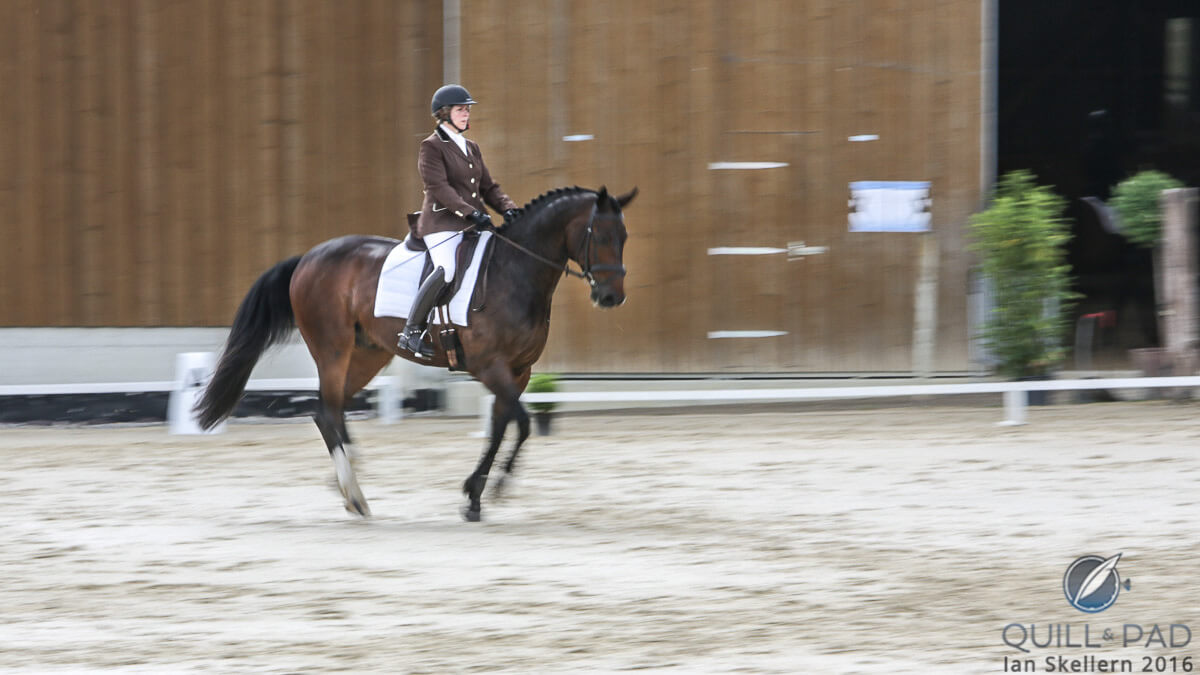
Brigitte and Gucci in 2016
With a lot of work he became an excellent dressage horse. In fact, physically and athletically he is likely to rank among the world’s best sport horses, but he is held back by the fact that he is also very smart and just doesn’t see the point in all that work. But Gucci is very special to us, forming an integral part of our family.
So when my parents were visiting around five years ago, Brigitte asked Neil to sketch Gucci. And he did.
The Reverso
Last year, seemingly out of the blue from my perspective, Brigitte told me that she would like a Jaeger-LeCoultre Reverso (wouldn’t we all?).
Now there are many reasons people might buy a Reverso, but for Brigitte it was the equine origins of the watch. With a rotating case to protect the watch inside, the Reverso was originally made for polo players worried about damaging their watches. With a Reverso you could rotate the case to put the relatively fragile crystal face down, so any knocks and bumps fell harmlessly on the back of the case.
Brigitte had done her homework: she knew exactly which model she wanted down to the reference number; it was a manual winding Reverso Classique in stainless steel with matching steel bracelet. This was to be a watch she could wear daily, which usually included office, horseback, and stables.

Jaeger-LeCoultre Caliber 846/1
And it came with a very nice Jaeger-LeCoultre manual winding Caliber 846/1 movement. I was quietly pleased to learn that Brigitte had double-checked that her chosen model had a mechanical movement, not a quartz one.
So I contacted Jaeger-LeCoultre and placed an order. And then when I received a message that the watch was ready, I was asked whether I’d like to pick it up from Jaeger-LeCoultre in Le Sentier, the JLC boutique in Geneva, or have it shipped.
Commissioning engraving
It was only then that we thought: it’s a Reverso; it has a back just imploring to be engraved; it has an easy rotation system so that artwork on the back is easily visible; and Jaeger-LeCoultre has some of the world’s finest engravers. Why don’t we have it personalized?
Interestingly, even though it was clearly Brigitte’s watch, it felt like a shared project and still feels like that many months later.
I would highly recommend to anyone thinking of commissioning an engraved Reverso to do so at the time of ordering the watch rather than my more haphazard approach of doing so later.
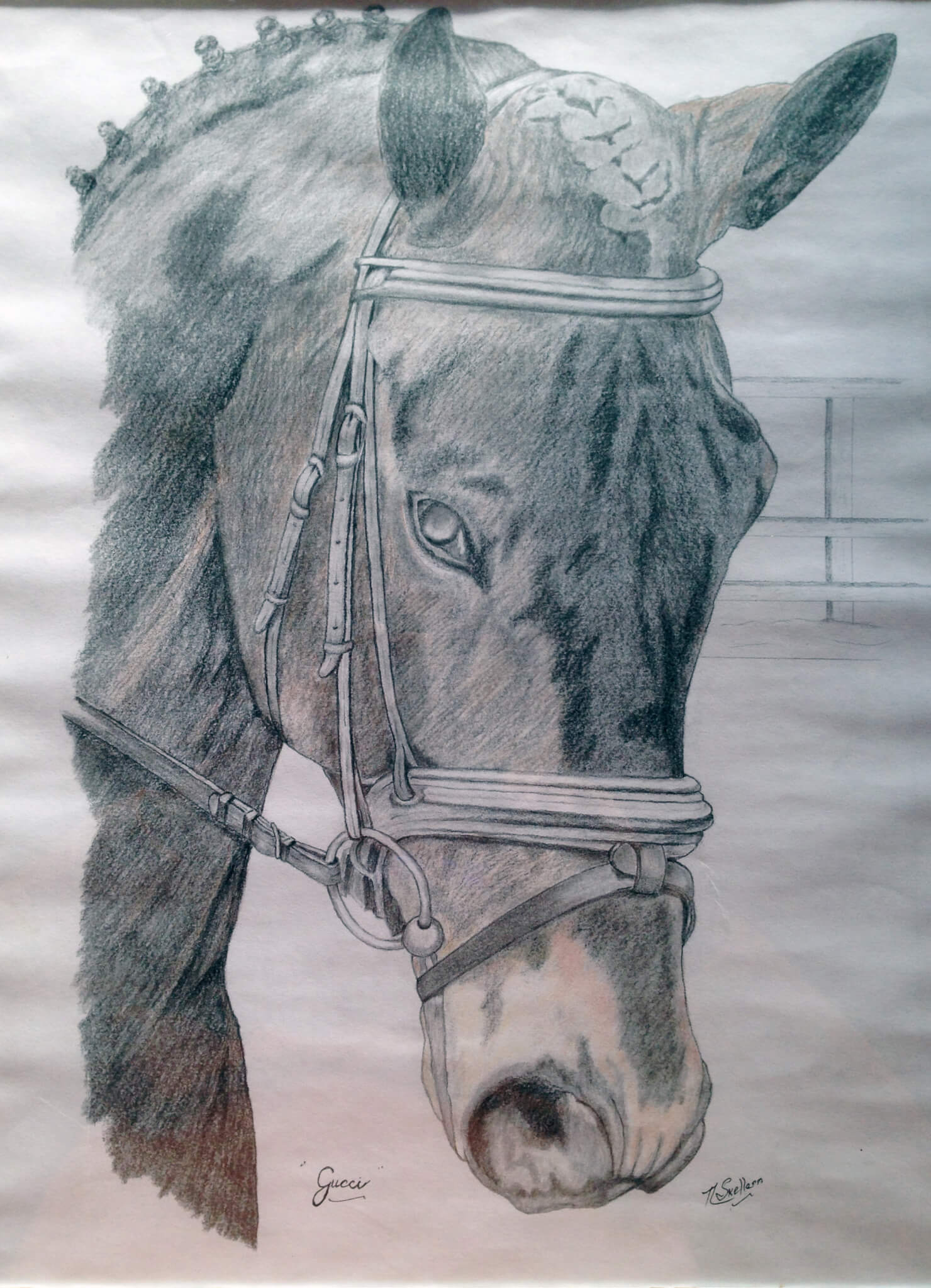
Neil Skellern’s sketch of Gucci, which inspired the engraving
As we looked for a suitable horsey portrait, it quickly became obvious that the subject had to be meaningful to us and of some artistic merit to be worth the expense, but also be casual (and, yes, cheap) enough that you would want the artwork around horses and stables.
It was quickly obvious that one sketch had the perfect subject and shape: Gucci.
So I sent a photo of the sketch to Jaeger-LeCoultre. A couple of weeks later, I received a small image of how the engraver thought the back would look and a quote for the work, which I accepted.
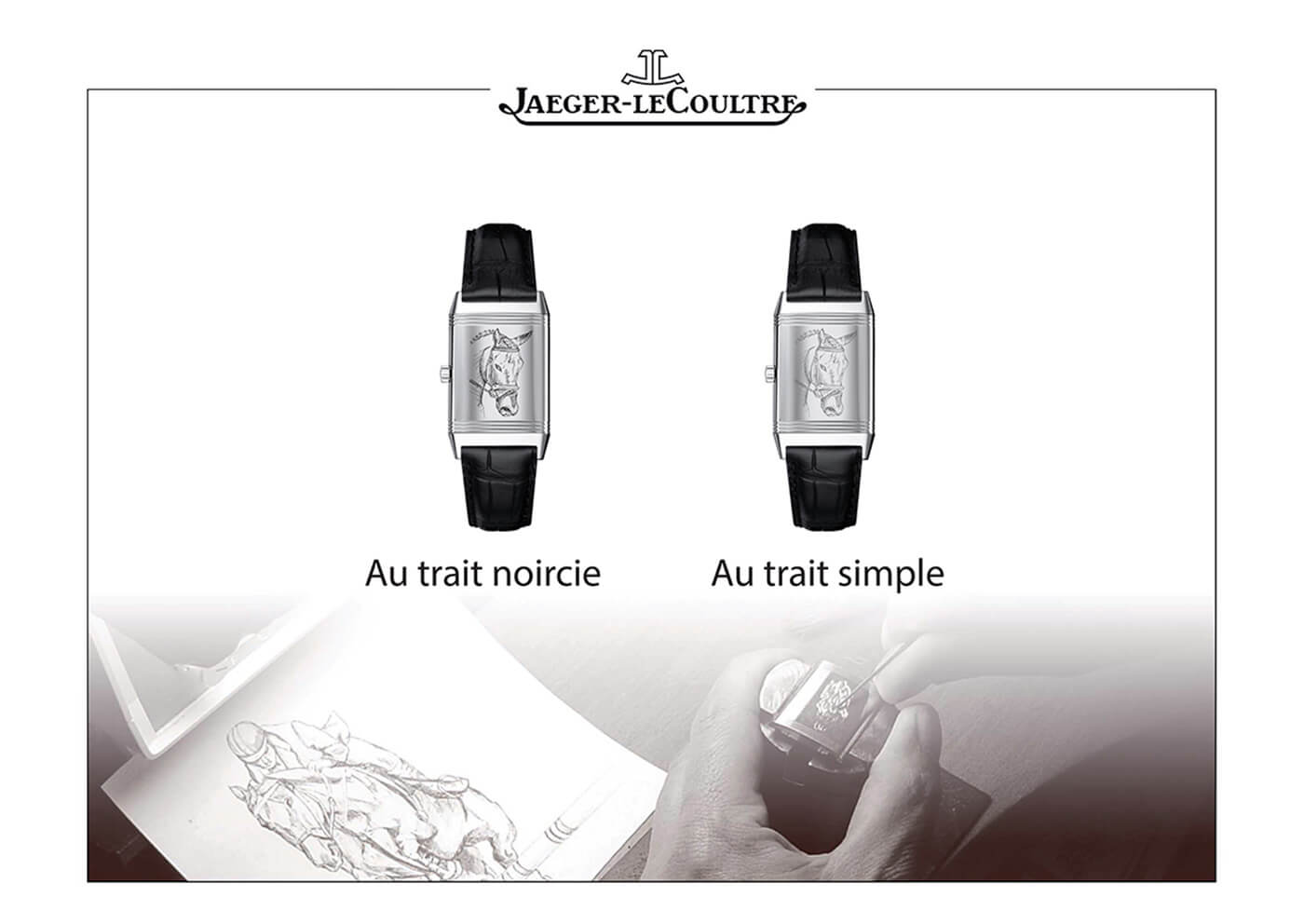
 How the engraver imagined the image of Gucci’s portrait on the back of a Jaeger-LeCoultre Reverso Classique
How the engraver imagined the image of Gucci’s portrait on the back of a Jaeger-LeCoultre Reverso Classique
I also asked if could I come up to the Jaeger-LeCoultre manufacture in Le Sentier to take a few photos while the watch was being engraved.
The engraving process for this depiction of Gucci took two full days, from translating the sketch I had sent into a design that can be engraved and still be seen and appreciated at postage-stamp size, freehand outlining (aka scratching) the basic lines onto the watch’s case back, the engraving itself, cold enamel blackening, and finally polishing.
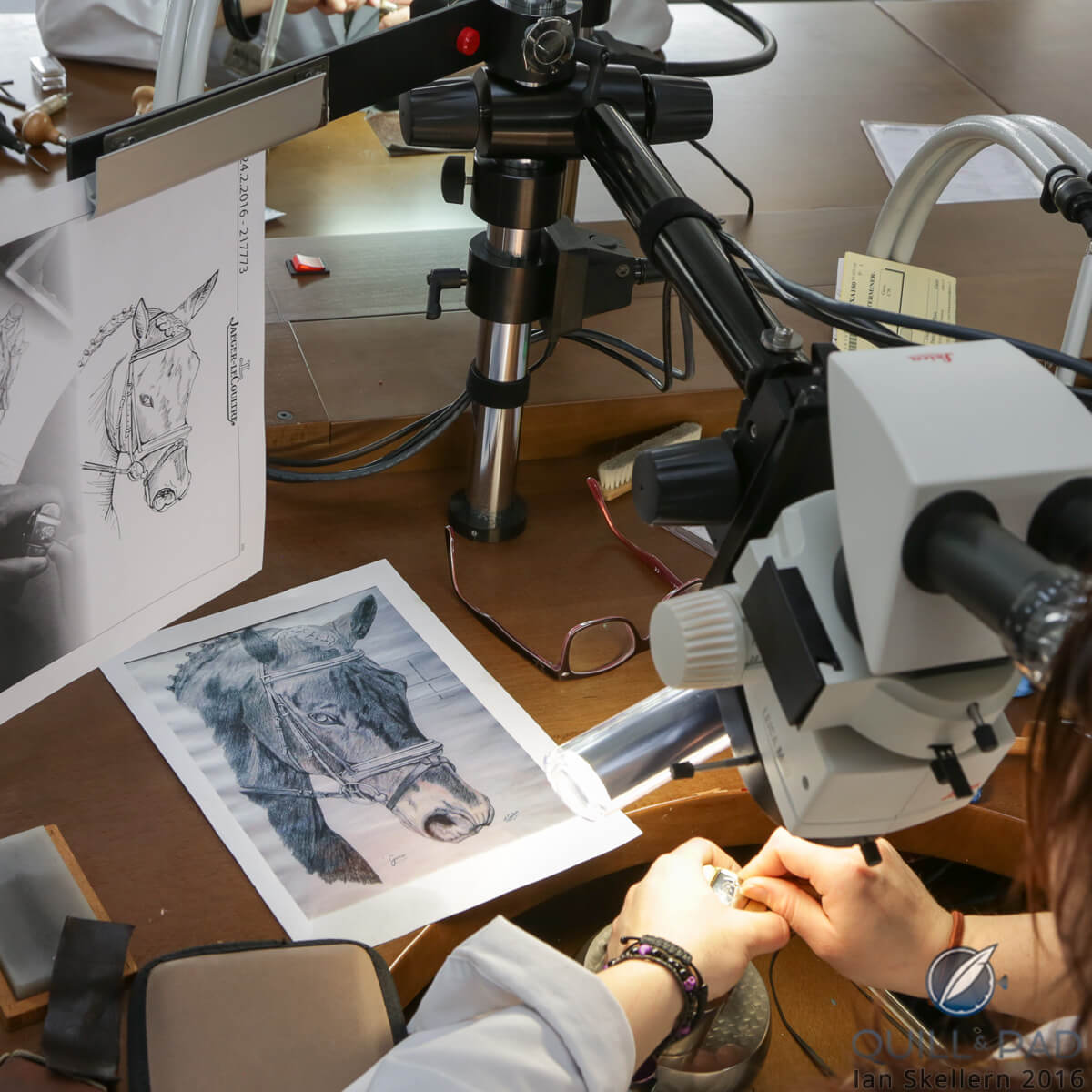
Jaeger-LeCoultre engraver Marsura working on the portrait of Gucci
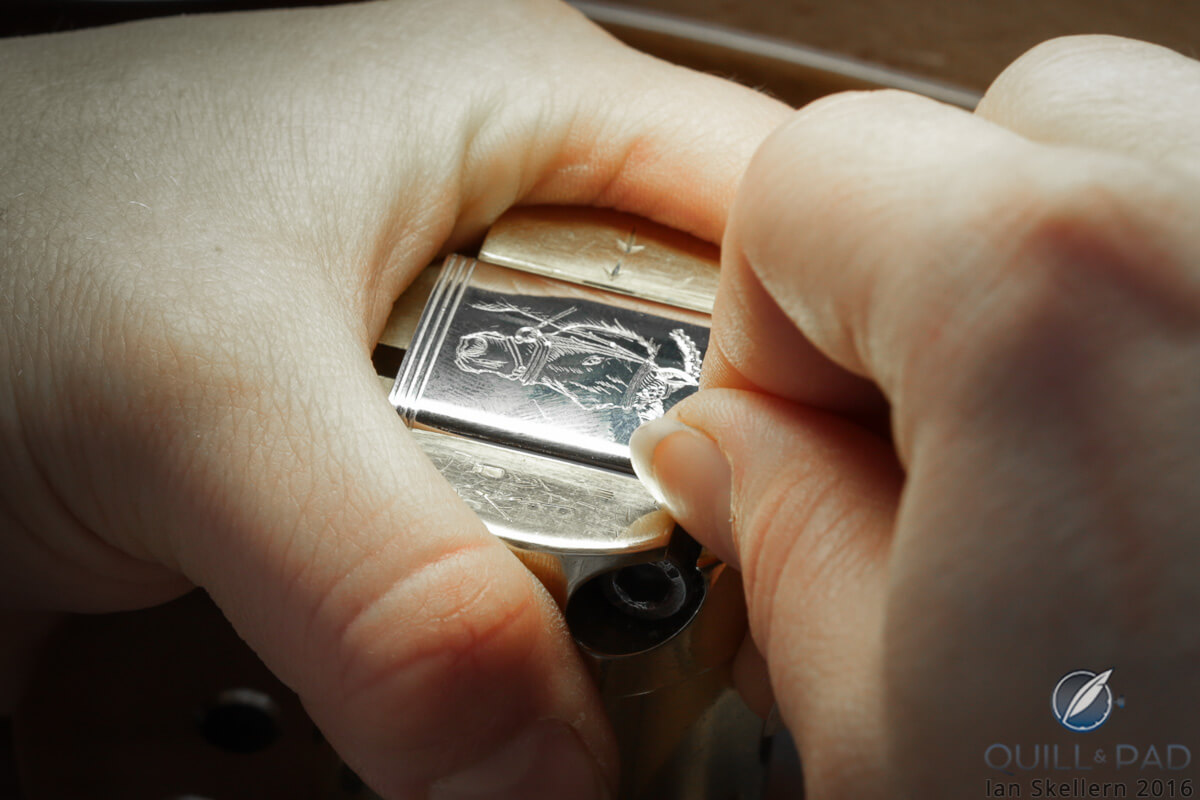
Jaeger-LeCoultre engraver Marsura working on the portrait of Gucci
It is essential to get that first design absolutely perfect otherwise nothing flows smoothly.
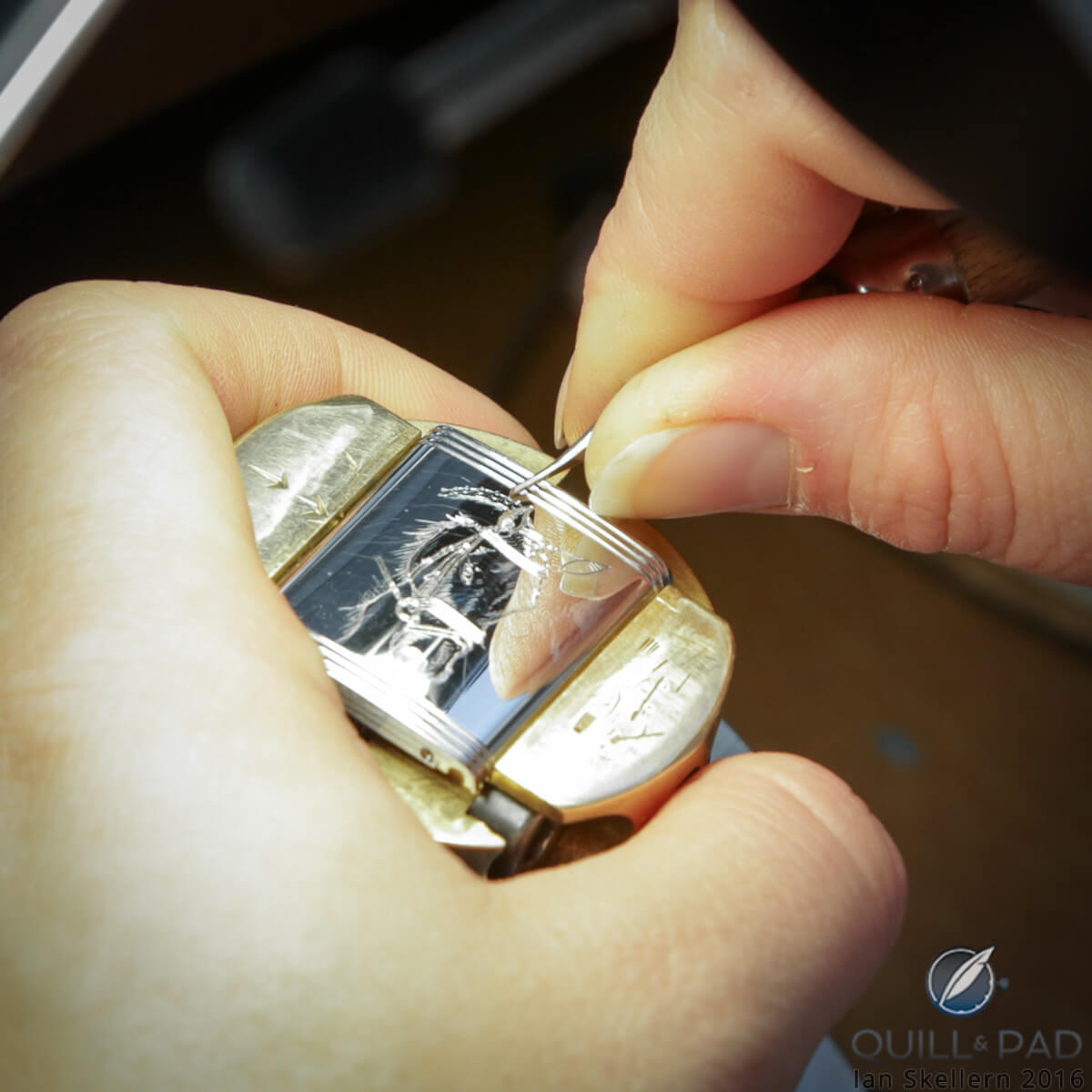
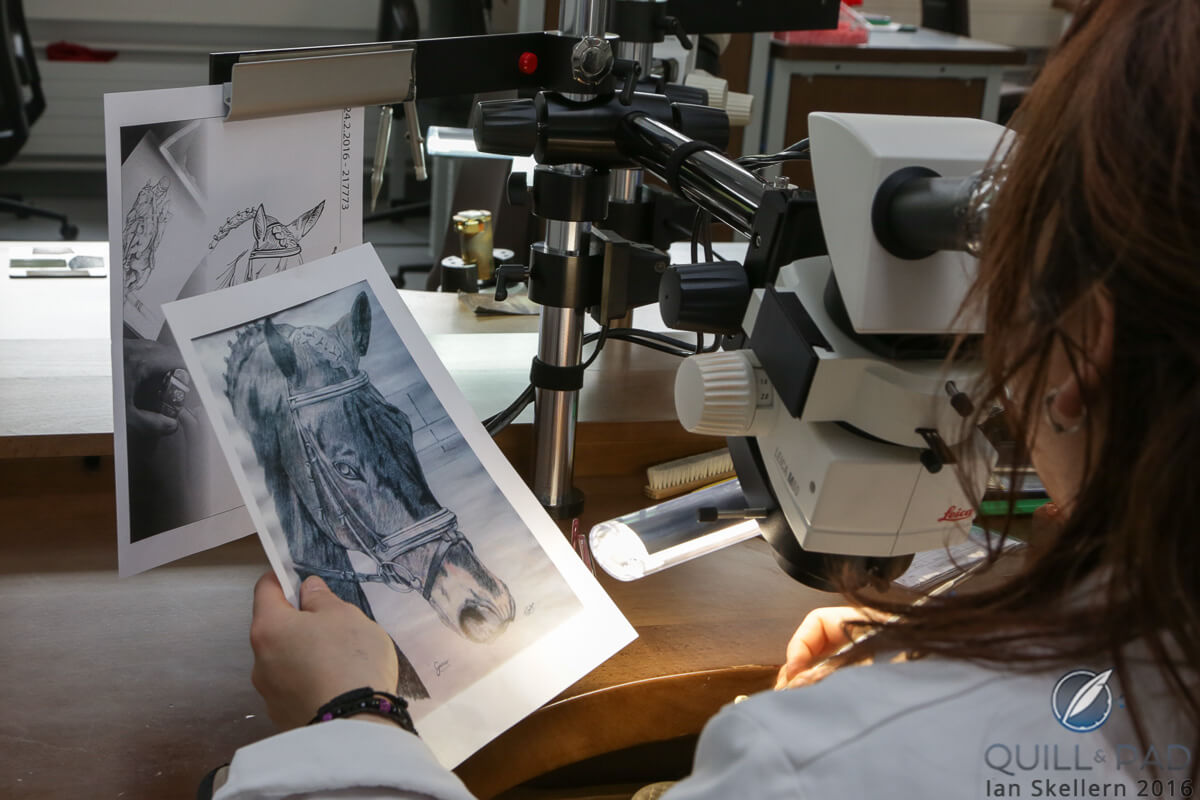
So our engraver Maroussia worked out which few hours in the process was likely to be the most visually interesting. And she chose well.
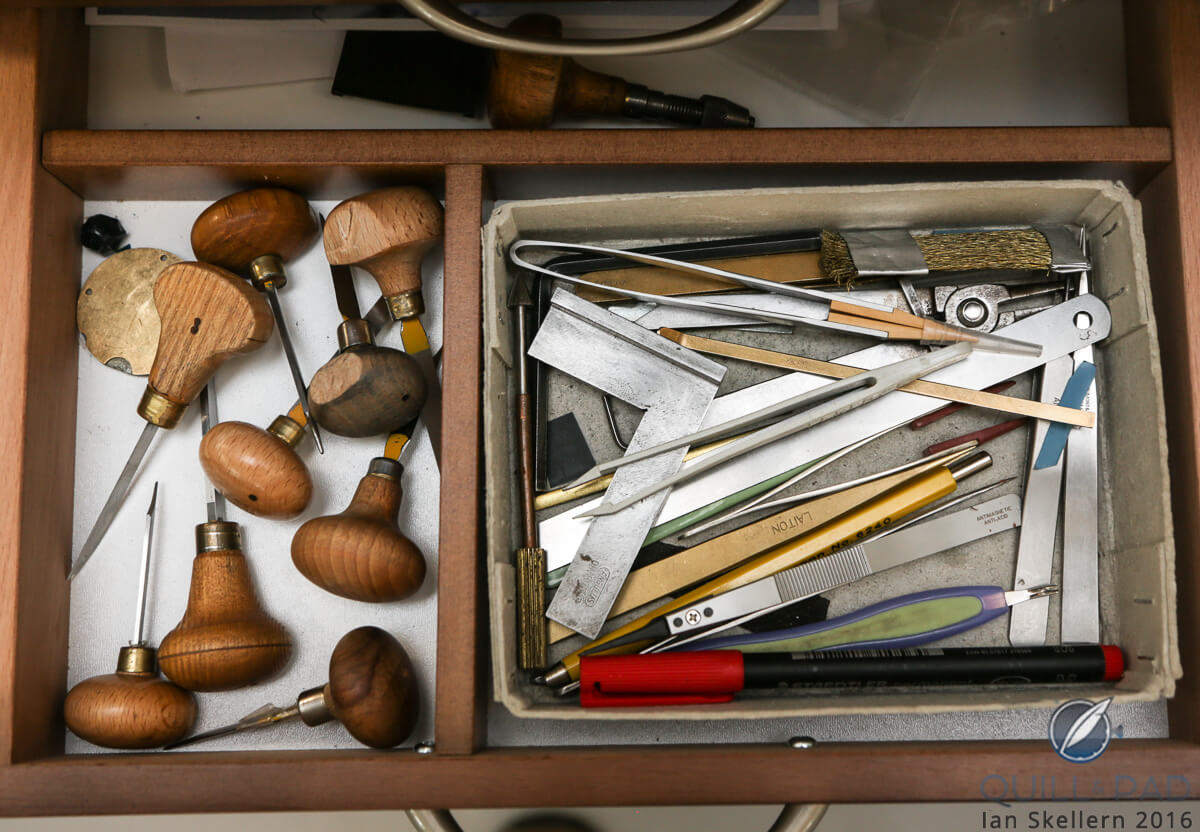
A few of the tools required for engraving at Jaeger-LeCoultre
Maroussia had studied art, design, and engraving. She has worked as an engraver at Jaeger-LeCoultre for six years. She told me that faces and portraits were the most difficult as it was critical to get the expression just right. The aim for her was not to replicate the original but to interpret it while keeping the essential. We feel that she did extremely well.
It’s worth remembering that this is stainless steel that is being engraved, a metal known for his strength and hardness, so it’s no easy material to sculpt.
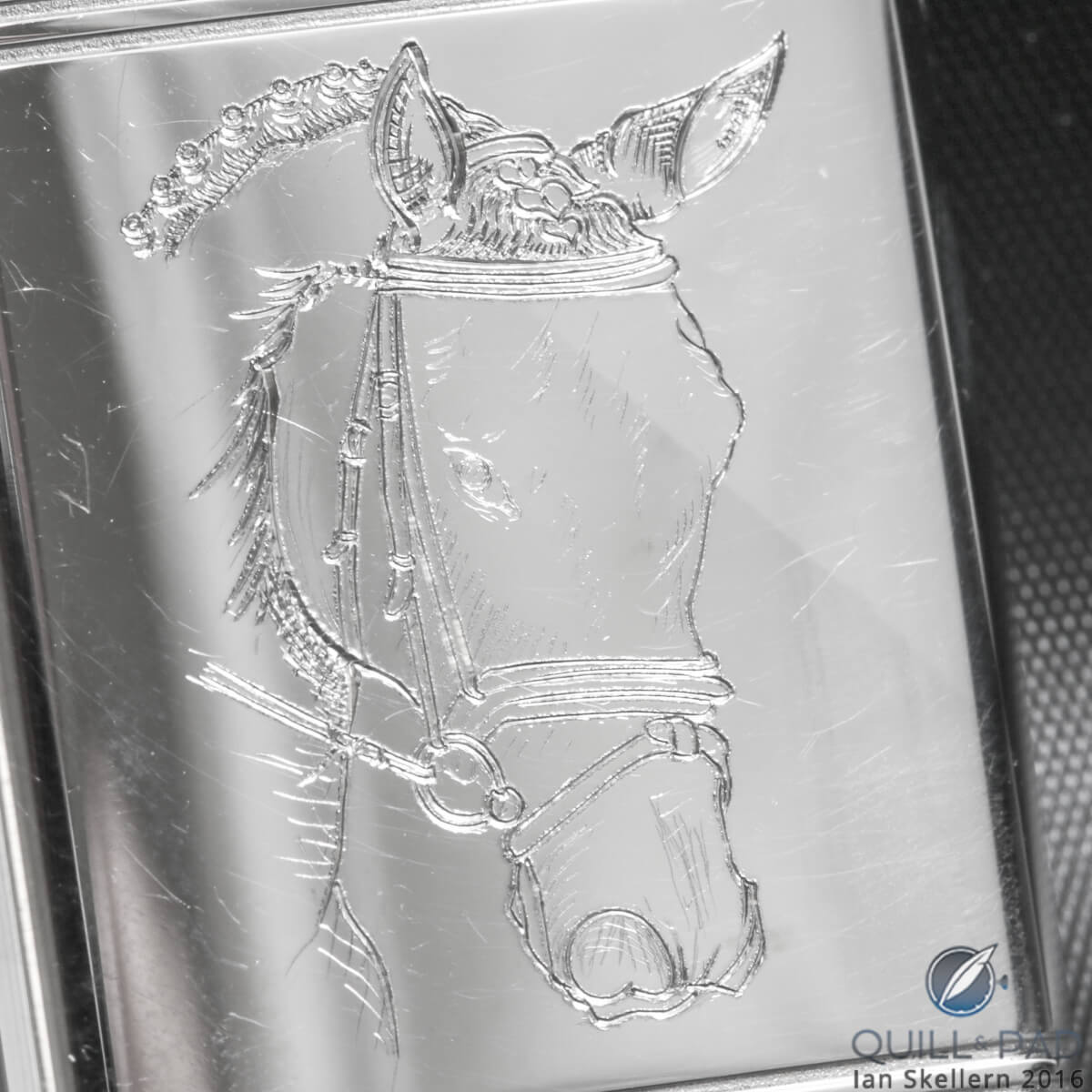
The image of Gucci begins to look complete, though there is still another full day of work ahead (note that this is a work in progress before final polishing)
Gucci came home.
Conclusion
If you got this far then it’s pretty clear to you that Brigitte is very happy with the engraving of Gucci on her Reverso Classique — and if she is happy then I am happy — so why did I recommend in the title that you shouldn’t do the same?
Well, to be honest the main reason I added that was that I thought it might encourage more people to read the article. The whole raison d’être for the Reverso case in the first place was so that those playing polo — quite a rough sport with hard objects flying through the air at high speed (see Polo: The Sport Of Kings, And Thanks To Richard Mille, Yours Truly) — could turn the relatively fragile crystal face down, leaving the tough steel back to absorb any knocks.
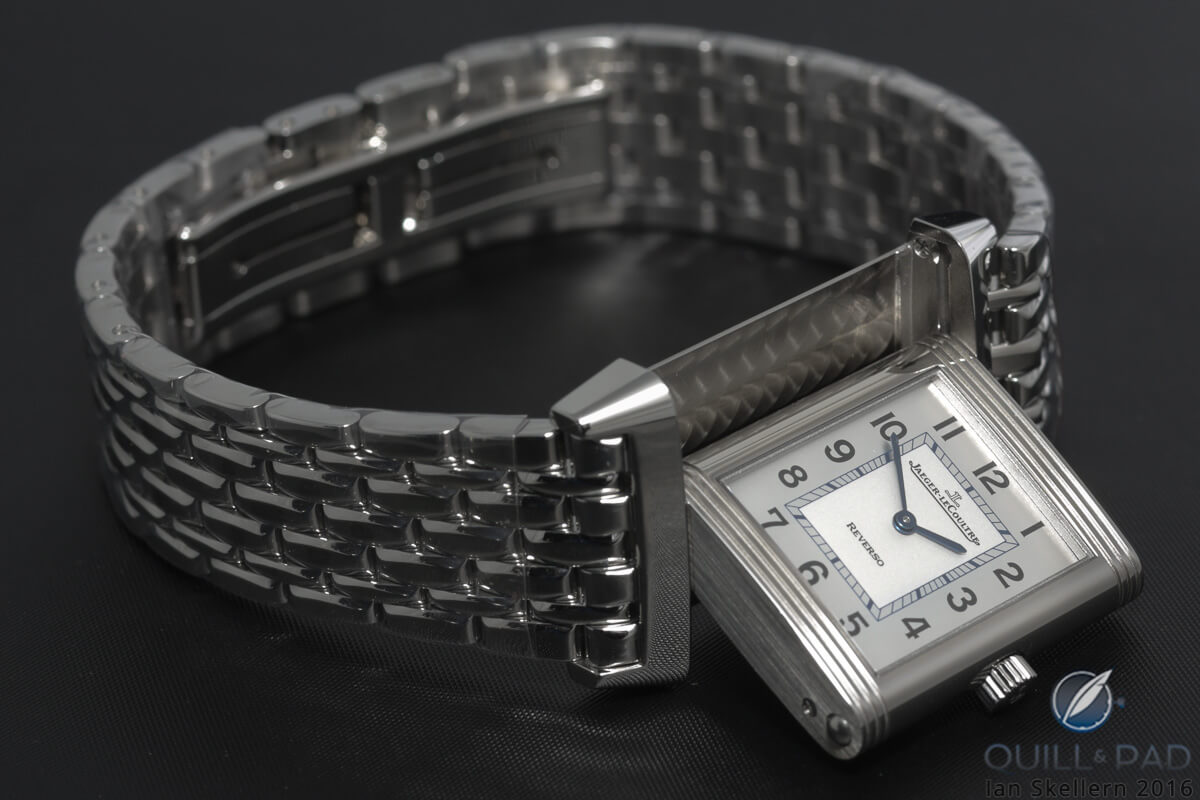
Jaeger-LeCoultre Reverso Classique
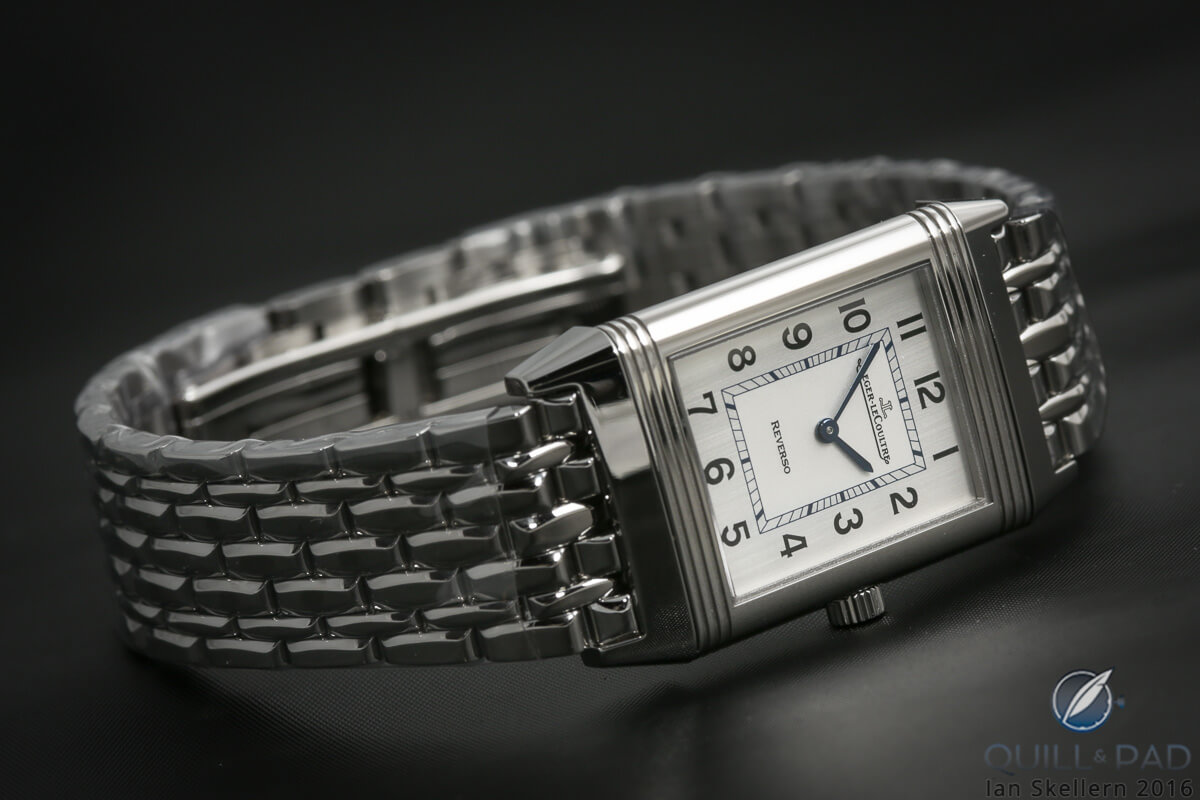
Jaeger-LeCoultre Reverso Classique
Now what happens if you have relatively expensive and emotionally valuable artwork on the back? You keep that face down and let the crystal fend for itself, completely negating the whole point of having a Reverso in the first place. But I concede that unless you are actually a high-level polo player who insists on wearing a watch while playing, that’s unlikely to be a problem.

Engraving of Gucci on the back of Brigitte’s Jaeger-LeCoultre Reverso Classique

Engraving of Gucci on the back of Brigitte’s Jaeger-LeCoultre Reverso Classique
The pleasure of commissioning a miniature piece of art and having it literally “on hand” to appreciate anytime cannot be overestimated, and the Reverso is in a class of its own for that – as are the wide range of artistic skills available at Jaeger-LeCoultre.
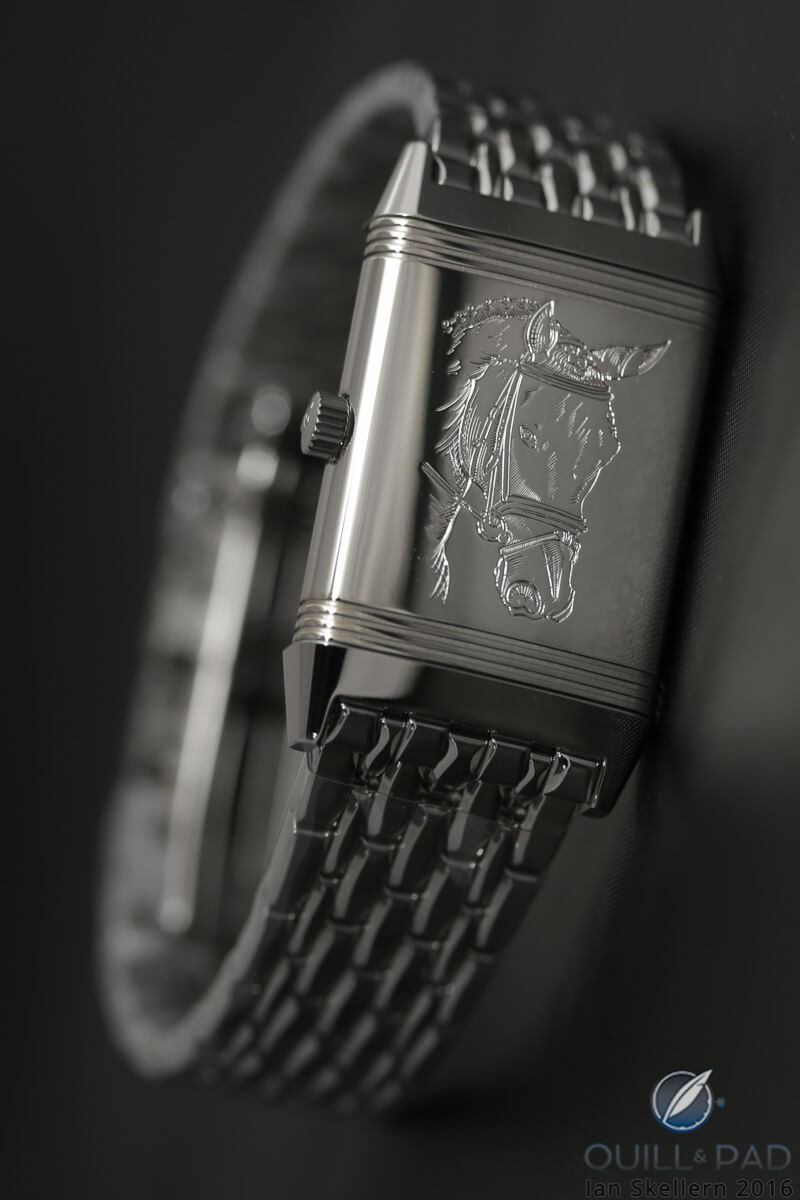
Jaeger-LeCoultre Reverso Classique showing the engraving of Gucci
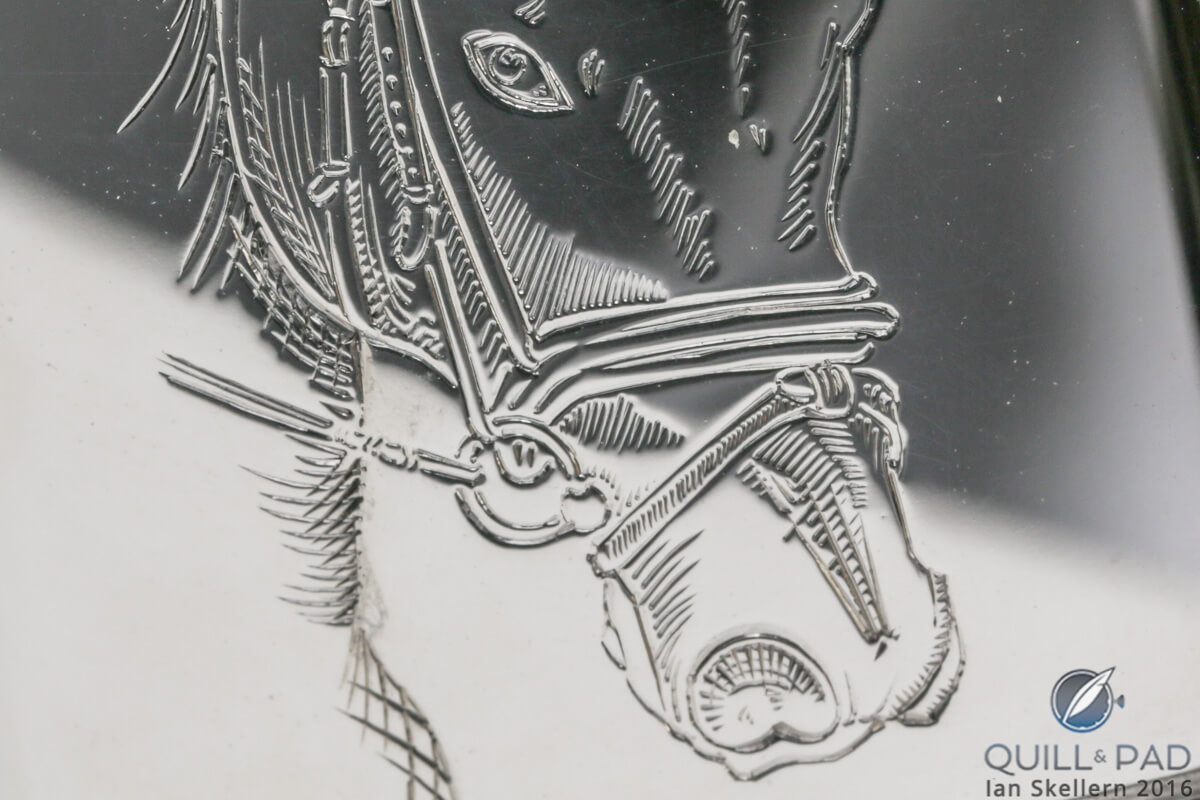
A close look at the details in the engraving of Gucci on the back of Brigitte’s Jaeger-LeCoultre Reverso Classique
And here is something else you might consider: I’m a pretty selfish person and I would quite like a Reverso myself. But I’m sure that I have got a lot more pleasure out of commissioning this Reverso for Brigitte than if I had bought one for myself.
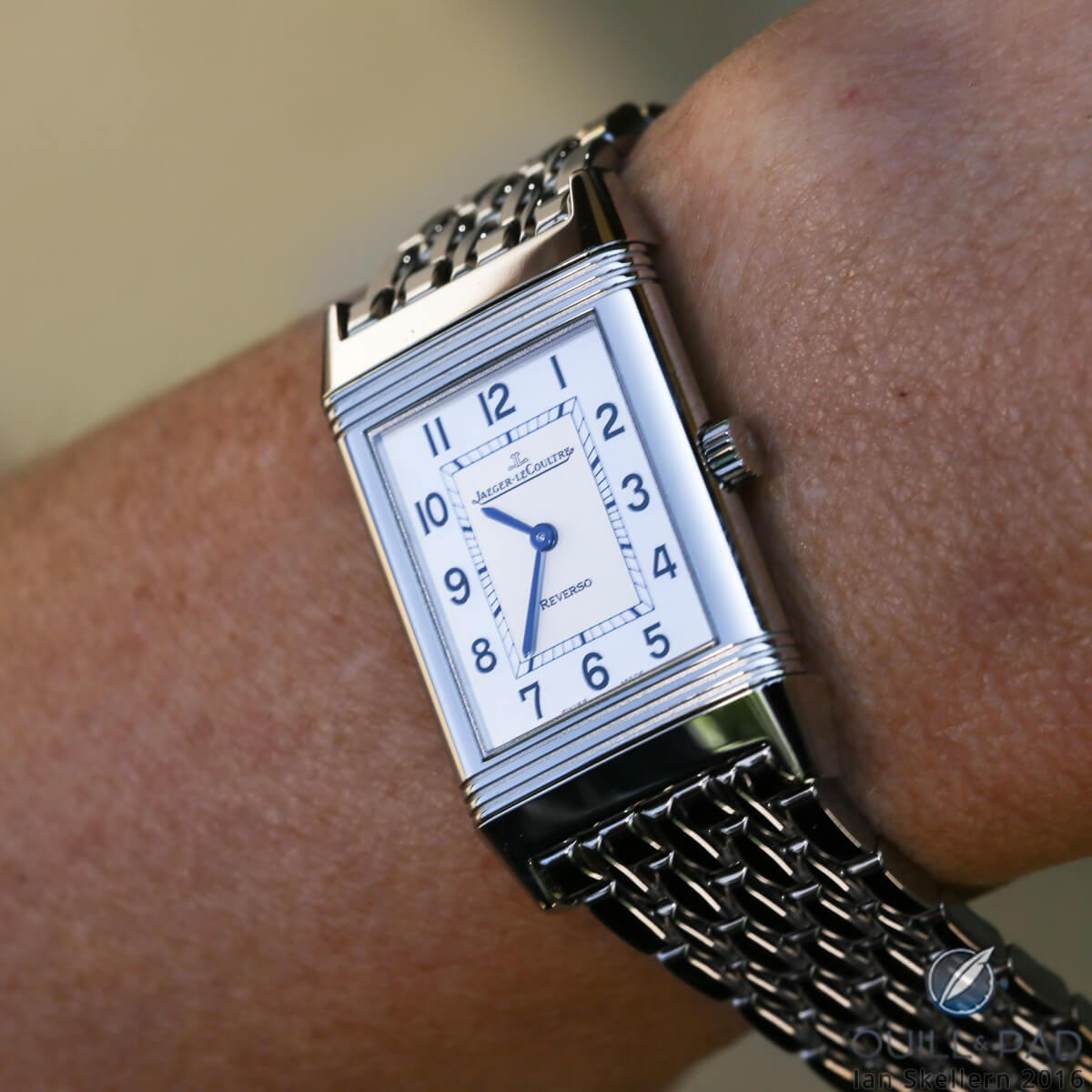
Jaeger-LeCoultre Reverso Classique on the wrist
For more information, please visit www.jaeger-lecoultre.com/us/en/watches/reverso.
Quick Facts Jaeger-LeCoultre Reverso Classique
Case: reversible, 38.7 x 23 x 8.5 mm, stainless steel
Movement: manual winding Caliber 846/1, 38-hour power reserve
Functions: hours, minutes
Price: $6,500, engraving approximately $2,000 (price depends entirely on the subject and details required)
Trackbacks & Pingbacks
-
[…] You might also enjoy Why I Bought My Wife An Engraved Jaeger-LeCoultre Reverso Classique. […]
-
[…] This article was first published on June 1, 2016 at Why I Bought My Wife An Engraved Reverso Classique . . . And Why You Shouldn’t (Even Though I’m …. You may find the comments there […]
-
[…] to say that here at Quill & Pad we are big fans of the Jaeger-LeCoultre Reverso (see Why I Bought My Wife An Engraved Reverso Classique . . . And Why You Shouldn’t (Even Though I’m … and Why I Bought It: Jaeger-LeCoultre Tribute To Reverso […]
Leave a Reply
Want to join the discussion?Feel free to contribute!



What a fantastic article. Informative and a great story too.
A Reverso features in my future buys and the engraving is vey tempting and fairly priced I feel.
Thank you!
Thank you for your support, Mark. For the amount of work involved and relatively high Swiss wages, I thought that the engraving was very fairly priced as well.
Ian, another great piece! Elizabeth recommended it to me for a piece I’m currently working on, Happy Wife, Happy Life–What Women Really Want in a Watch. Brigitte is a lucky woman having such a watch savant to guide her choices.
–Chris
Thanks, Chris.
Mesmerized by the work. Thank you for sharing your story.
Thank you for your kind words, Amay.
I thoroughly enjoyed reading your story Ian and agree with you completely about the title, it drew me in.
The end result looks fantastic and the cost of the engraving is quite reasonable considering the work involved.
I hope the watch brings you both many years of happiness.
I will not be shy in updating with long-term user reports, Dan, but the Reverso is certainly off to a good start as far as generating pleasure goes.
I think your story is s great example of what watch collecting should be about but unfortunately usually isn’t. I enjoyed it a lot and love your wife’s watch. Not as much as she does though I am sure.
Thanks, Steve. It just goes to show how much Jaeger-LeCoultre is benefiting from offering a comprehensive and attractive range of high-end mechanical ladies watches, whereas for most brands feminine watches are still an afterthought.
I was intrigued by the title of your article, and enjoyed reading it to the end.
The watch is beautiful and the engraving is amazing!
Thank you for sharing this great story.
Thank you, Kim, I’m sorry to have deceived with the title, but if it encourages a few more people to look at the article then I’ll live comfortably with the guilt.
A great read, very personal, yet very accessible. Articles like this compete greatly with my existing belief that the modern Reverso is best executed with a sapphire caseback. While I love the idea of wear a movement on the wrist, a piece of personal art is even more soulful.
This was totally misleading. A long winded irrelevant background that ended in the writer showing off a simple engraving on a regular watch. I thought I’d learn something…
I’m sorry that you didn’t enjoy the article, Veda. Were there too many big words that you didn’t understand?
Hello! I enjoyed reading about the whole process and the care that went into taking home an engraved Reverso.
Could you please write about the Breguet Marine that preceded it? Marines don’t get much press, particularly the women’s models.
Thanks!
I thoroughly enjoyed your article Ian. Very nicely written. I agree with you that most times, it is far more enjoyable experiencing the joy and satisfaction of a process like this when it’s a loved one who is going to be enjoying the finished project rather than one’s self. There is something very special about seeing a loved one’s vision come together. I wish I could talk my wife into doing something like this.
In closing, I wanted to tell you that you are not alone in your personal reaction to past pet’s memories. I have found out that they are tears of joy as often as tears of sadness.
Thank you for your kind words John. I have to say that I didn’t talk my wife into the project, after years of being exposed to but having little apparent interest in horology, she spontaneously decided that she “needed” a Reverso and had even researched the specific model. It was only the engraving that was my idea. And, yes, when it comes to pets, the more the pleasure, the more the pain: but if you are lucky, the former lasts much longer than the latter.
Regards, Ian